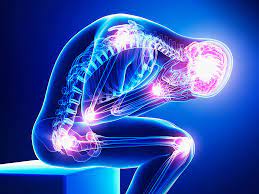Since the body naturally employs pain as a protective mechanism to detect harm or potential injury, there is a paradoxical relationship between pain and relief. At its core, pain management aims to alleviate suffering, improve quality of life, and restore function—a basic human urge. However, sometimes these efforts have unanticipated consequences, making the path to relief a double-edged sword. This issue encompasses the challenges associated with handling persistent pain, the psychological consequences of continuous discomfort, the risks associated with the use of particular medications, and the broader societal implications.
The Complexity of Chronic Pain Management
Pain lasting more than three to six months is referred to as chronic pain, and it represents a particularly challenging aspect of the problem. Chronic pain can be challenging to diagnose and treat, in contrast to acute pain, which typically has a well-defined source and a well-defined course for alleviation. The issue arises when pain management strategies inadvertently contribute to a loop of dependency, tolerance, and, on rare occasions, a worsening of the initial suffering.
The use of pharmaceuticals, especially opioids, is a good example of this paradox. They first offer a considerable lot of respite, allowing patients to function more normally than they would in cases of uncontrollably excruciating pain. However, with time, the body could become accustomed to these medications and need higher dosages to achieve the same level of pain relief, increasing the risk of addiction and dependence. The phenomenon of hyperalgesia—the increased sensitivity to pain that can result from prolonged opiate use—highlights the paradoxical nature of seeking relief.
The Psychological Impact of Seeking Relief
There are important psychological effects of seeking pain relief as well. When dealing with chronic pain, emotions such as annoyance, melancholy, and anxiety are common, especially when finding treatment is hard or when getting relief presents its own set of obstacles. The psychological struggle can result in a vicious cycle where pain and the need for relief feed off each other, making therapy more challenging and lowering the patient's quality of life.
Furthermore, because certain pain management techniques—particularly the use of opioids—are stigmatized, persons who are experiencing pain may feel alone and ashamed. People may be reluctant to seek treatment due to this stigma because they fear judgment for using medicines or for not being able to manage their pain via "willpower" alone.
Risks and Alternatives in Pain Relief Methods
Opioids are not the only medications that have risks; over-the-counter medications, invasive procedures, and even complementary and alternative therapies may as well. For instance, long-term use of nonsteroidal anti-inflammatory drugs (NSAIDs) might result in issues with the kidneys, gastrointestinal tract, and cardiovascular system. NSAIDs are often used and generally safe when taken momentarily. Invasive techniques, such as surgery or injections, have a risk of side effects and may worsen pain instead of relieving it.
This insight has led to a rise in interest in and study of complementary pain management strategies that aim to reconcile the paradox by offering effective pain relief with minimal adverse effects. Pain relief techniques including physical therapy, acupuncture, mindfulness-based stress reduction, and cognitive-behavioral therapy that rely on the body's and mind's innate capacity for healing and coping appear promising.
Moving Forward and Its Implications for Society
The paradox of pain alleviation transcends the healthcare system to the human level and has a significant impact on society as a whole. For example, the opioid crisis is a sobering reminder of the catastrophic outcomes of treating pain without considering the long-term effects that pain relief methods may have on individuals. It highlights the need for a comprehensive, well-rounded approach to pain management that considers the physical, psychological, and social dimensions of pain.
In the future, overcoming the paradox of pain relief will require a multidimensional approach with a focus on patient education, individualized care plans, and multimodal pain treatment strategies. To effectively navigate the intricacy of pain management, medical professionals must work in tandem with patients to ensure that the interventions they employ do not inadvertently exacerbate the disease they are attempting to treat.
Conclusion:
controlling chronic pain is very challenging due to the paradox of pain, which holds that trying to find relief from suffering might have unforeseen effects that worsen or aggravate it. It takes a thorough understanding of pain, an awareness of the psychological and social factors at play, and a commitment to researching and implementing long-term, holistic pain treatment strategies to comprehend and resolve this contradiction. Acknowledging this complexity will make it easier for patients and healthcare providers to walk the tightrope between minimizing suffering and avoiding unintended effects from being alleviated, which will result in a more effective and compassionate approach to pain management


No comments yet